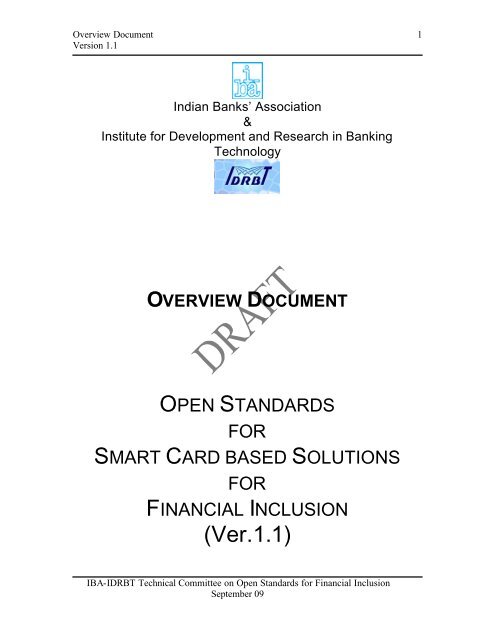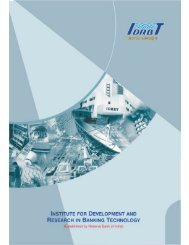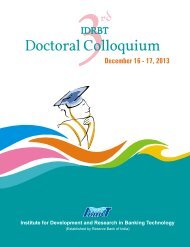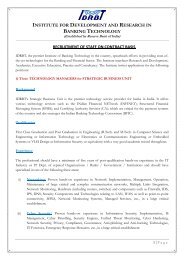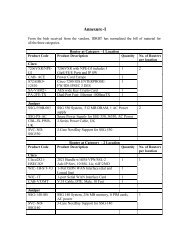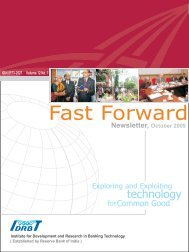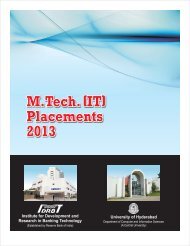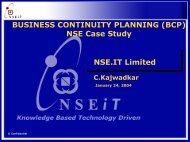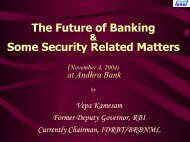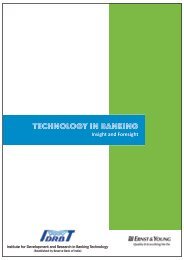FI Overview Document Version 1.1.pdf - IDRBT
FI Overview Document Version 1.1.pdf - IDRBT
FI Overview Document Version 1.1.pdf - IDRBT
Create successful ePaper yourself
Turn your PDF publications into a flip-book with our unique Google optimized e-Paper software.
<strong>Overview</strong> <strong>Document</strong><br />
<strong>Version</strong> 1.1<br />
1<br />
Indian Banks’ Association<br />
&<br />
Institute for Development and Research in Banking<br />
Technology<br />
OVERVIEW DOCUMENT<br />
OPEN STANDARDS<br />
FOR<br />
SMART CARD BASED SOLUTIONS<br />
FOR<br />
<strong>FI</strong>NANCIAL INCLUSION<br />
(Ver.1.1)<br />
IBA-<strong>IDRBT</strong> Technical Committee on Open Standards for Financial Inclusion<br />
September 09
<strong>Overview</strong> <strong>Document</strong><br />
<strong>Version</strong> 1.1<br />
2<br />
Contributors<br />
1. SHRI S.K. SINHA,<br />
SENIOR TECHNICAL DIRECTOR,<br />
NATIONAL INFORMATICS CENTRE<br />
3. SHRI S. MUKHOPADHYAY,<br />
GENERAL MANAGER,<br />
STATE BANK OF INDIA<br />
5. DR. K. RAVINDRANATH,<br />
CHIEF MANAGER,<br />
UNION BANK OF INDIA<br />
2. DR. PHALGUNI GUPTA,<br />
PROFESSOR,<br />
INDIAN INSTITUTE OF TECHNOLOGY<br />
KANPUR<br />
4. SHRI S. C. DHOLE,<br />
GENERAL MANAGER,<br />
UCO BANK<br />
6. SHRI R.SUBRAMANIAKUMAR,<br />
ASSISTANT GENERAL MANAGER,<br />
PUNJAB NATIONAL BANK<br />
7. SHRI K. RAMACHANDRAN,<br />
ASSISTANT GENERAL MANAGER,<br />
CORPORATION BANK<br />
8. SHRI N. P. MOHAPATRA,<br />
ASSISTANT GENERAL MANAGER,<br />
NABARD<br />
9. SHRI RAMESH KUMAR,<br />
GENERAL MANAGER,<br />
SOUTH MALABAR GRAMEEN BANK<br />
11. DR. M.V.N.K. PRASAD,<br />
ASSISTANT PROFESSOR,<br />
<strong>IDRBT</strong><br />
10. DR. V.N. SASTRY,<br />
ASSOCIATE PROFESSOR,<br />
<strong>IDRBT</strong><br />
12. DR. MAHIL CARR,<br />
ASSISTANT PROFESSOR,<br />
<strong>IDRBT</strong><br />
13. MS. PRABHUTA VYAS,<br />
SENIOR VICE PRESIDENT,<br />
INDIAN BANKS’ ASSOCIATION<br />
14. SHRI K.I. VAREED,<br />
VICE PRESIDENT,<br />
INDIAN BANKS’ ASSOCIATION<br />
IBA-<strong>IDRBT</strong> Technical Committee on Open Standards for Financial Inclusion<br />
September 09
<strong>Overview</strong> <strong>Document</strong><br />
<strong>Version</strong> 1.1<br />
3<br />
Contents<br />
1 Introduction 4<br />
1.1 Rationale for standardisation 6<br />
1.2 Challenges 6<br />
1.3 Advantages of Common Standards 7<br />
2 Smart Card based Solution for Financial Inclusion 9<br />
3 Standardization 11<br />
3.1 Card Numbering Scheme 11<br />
3.2 Smart Card Hardware 12<br />
3.3 Smart Card Operating System 13<br />
3.4 Smart Card Data Architecture<br />
Specifications for <strong>FI</strong> Bank Card 13<br />
3.5 Business Correspondent Card 14<br />
3.6 Terminal Functionality Specifications<br />
(Hardware and Software) 14<br />
3.6.1 Minimal Functionality 14<br />
3.6.2 Full Functionality 14<br />
3.6.3 Extended Functionality 14<br />
3.7 Smart Card Security 15<br />
3.8 Quality Assurance 15<br />
3.9 Key Management Scheme 15<br />
4 Conclusion 16<br />
IBA-<strong>IDRBT</strong> Technical Committee on Open Standards for Financial Inclusion<br />
September 09
<strong>Overview</strong> <strong>Document</strong><br />
<strong>Version</strong> 1.1<br />
4<br />
1 Introduction<br />
According to the Committee on Financial Inclusion (Jan.2008) the<br />
recent developments in Banking Technology have transferred<br />
banking from traditional brick and mortar infrastructure like<br />
staffed infrastructure to as system supplemented by other channels<br />
like ATMs, Credit/Debit Cards, Internet Banking, Online Money<br />
transfers etc. However, the access to the technology at present is<br />
restricted only to a certain segment of the society.<br />
According to the Committee “Access to finance by the poor and<br />
vulnerable groups is a prerequisite for poverty reduction and<br />
social cohesion. This has to become an integral part of our efforts<br />
to promote inclusive growth. In fact, providing access to finance is<br />
a form of empowerment of the vulnerable groups. Financial<br />
inclusion denotes delivery of financial services at an affordable<br />
cost to the vast sections of the disadvantaged and low-income<br />
groups. The various financial services include credit, savings,<br />
insurance and payments and remittance facilities. The objective of<br />
financial inclusion is to extend the scope of activities of the<br />
organized financial system to include within its ambit people with<br />
low incomes. Through graduated credit, the attempt must be to lift<br />
the poor from one level to another so that they come out of poverty.<br />
NSSO data reveal that 45.9 million farmer households in the<br />
country (51.4%), out of a total of 89.3 million households do not<br />
access credit, either from institutional or non-institutional sources.<br />
Further, despite the vast network of bank branches, only 27% of<br />
total farm households are indebted to formal sources (of which<br />
one-third also borrow from informal sources). Farm households<br />
not accessing credit from formal sources as a proportion to total<br />
farm households is especially high at 95.91%, 81.26% and 77.59%<br />
in the North Eastern, Eastern and Central Regions respectively.<br />
Thus, apart from the fact that exclusion in general is large, it also<br />
varies widely across regions, social groups and asset holdings.<br />
IBA-<strong>IDRBT</strong> Technical Committee on Open Standards for Financial Inclusion<br />
September 09
<strong>Overview</strong> <strong>Document</strong><br />
<strong>Version</strong> 1.1<br />
5<br />
The poorer the group, the greater is the exclusion.” (Rangarajan,<br />
2008)<br />
Based on the above consideration, a broad working definition of<br />
Financial Inclusion can be as under:<br />
“Financial inclusion may be defined as the process of ensuring<br />
access to financial services and timely and adequate credit where<br />
needed by vulnerable groups such as weaker sections and low<br />
income groups at an affordable cost.”<br />
Extending banking to the rural areas where there are no bank<br />
branches, consistent power supply or communication links such as<br />
telephones or Internet is a daunting task. This calls for newer<br />
approaches in taking banking to remote regions. One solution that<br />
RBI has come up with is to enable customers intermediate banking<br />
facilities through business correspondents who act as agents on<br />
behalf of banks. As law mandates, any transaction on an account<br />
involving cash has to be made within the physical premises of the<br />
bank. The Reserve Bank of India has permitted the appointment of<br />
business correspondents who have the authority to accept deposits<br />
or make cash payments when customers would like to withdraw or<br />
deposit money from or to their accounts at locations other than<br />
bank premises. Instead of opening full-blown brick and mortar<br />
bank branches in remote districts (an expensive proposition) it is<br />
proposed that with the help of modern information technology and<br />
managerial capabilities of business correspondents banking<br />
functionalities could be extended to remote regions.<br />
IBA-<strong>IDRBT</strong> Technical Committee on Open Standards for Financial Inclusion<br />
September 09
<strong>Overview</strong> <strong>Document</strong><br />
<strong>Version</strong> 1.1<br />
6<br />
1.1 Rationale for Standardization in<br />
Smart Card Solutions<br />
Many banks have started implementing financial inclusion projects<br />
with the help of Information and Communication Technology (ICT)<br />
solutions. Broadly, two technologies have been so far explored.<br />
One is based on Smart Card technology and the other is based on<br />
Mobile based solutions. Smart card solutions have been relatively<br />
easily implemented compared to the mobile based solution as it is<br />
in nascent stage. In this document, an attempt has been made to<br />
consider the issues related to Smart Card solution.<br />
Various implementations of the smart card-based solutions have<br />
been initial pilots and have not been scaled up and are quite limited<br />
in their scope. In many pilots all the three components viz. Smart<br />
cards, Bank terminals and Business Correspondent services are<br />
provided by the same vendor/group.<br />
1.2 Challenges<br />
Almost all the banks, barring a couple have not been able to roll<br />
out the pilots. The challenges are to enable:<br />
• Making large-scale procurement and implementation of end<br />
to end solution difficult.<br />
• Rendering intra-bank as well as inter-bank interoperability<br />
difficult due to proprietary solutions.<br />
• Problems in interfacing with CBS platforms.<br />
• Lack of standard technology components of the smart card<br />
based solution across the industry.<br />
• Lack of an authority for testing and certifying that the<br />
specified standards for smart cards, bank terminals are<br />
complied with and adhered to.<br />
IBA-<strong>IDRBT</strong> Technical Committee on Open Standards for Financial Inclusion<br />
September 09
<strong>Overview</strong> <strong>Document</strong><br />
<strong>Version</strong> 1.1<br />
7<br />
• Ensuring data security of cards and terminals during<br />
manufacture, storage and transit.<br />
• Designing and implementing a common Key Management<br />
System that works across different vendor implementations.<br />
• Evolving a business model that makes the business<br />
correspondent model viable as costs are high due to small<br />
size and multiple technology solutions.<br />
1.3 Advantages of Common Standards<br />
• Common standards facilitate pan India deployment by the<br />
bank.<br />
• Common standards would bring in demand aggregation and<br />
economies of scale in procurement and deployment.<br />
• Common standards help in accelerating ICT deployment and<br />
avoid vendor lock in for all technology components.<br />
• Common standards enhance convenience to customers and<br />
provide inter-bank and intra-bank access.<br />
To address these issues IBA and <strong>IDRBT</strong> teamed up to organise a<br />
workshop on “Open Standards for Financial Inclusion”. After<br />
deliberations of the various issues, a “Technical Committee on<br />
Open Standards for Financial Inclusion” was constituted<br />
comprising of a few select banks like State Bank of India, Punjab<br />
National Bank, Union Bank of India, Corporation Bank, South<br />
Malabar Gramin Bank, UCO Bank, NABARD and institutions like<br />
IIT Kanpur and National Informatics Centre (NIC). This<br />
Committee ‘IBA – <strong>IDRBT</strong> Technical Committee on Open<br />
Standards for Financial Inclusion’ has been working since<br />
February 2009. The first draft of the technical standards<br />
specification deals with the smart card based solution standards<br />
which relate to the following areas: the card numbering scheme,<br />
the smart card hardware, the smart card operating system, the<br />
smart card architecture, the bank terminal functionality and the<br />
IBA-<strong>IDRBT</strong> Technical Committee on Open Standards for Financial Inclusion<br />
September 09
<strong>Overview</strong> <strong>Document</strong><br />
<strong>Version</strong> 1.1<br />
8<br />
security framework (the key management system). The draft also<br />
deals with a migration path for adoption of these standards and<br />
certification for adherence to these standards.<br />
The draft report is now placed in public domain for suggestions<br />
and comments by all stake holders such as public, banks,<br />
technology solution providers, microfinance institutions, NBFCs,<br />
NGOs, self help groups etc. We are confident that finalisation of<br />
these open standards will facilitate an efficient roll-out of the<br />
Financial Inclusion projects which will be user friendly and nonproprietary<br />
by making bank terminals interoperable.<br />
IBA-<strong>IDRBT</strong> Technical Committee on Open Standards for Financial Inclusion<br />
September 09
<strong>Overview</strong> <strong>Document</strong><br />
<strong>Version</strong> 1.1<br />
9<br />
2 Smart Card based Solution for<br />
Financial Inclusion<br />
Information technology should enable banks to provide services<br />
that have the following business requirements:<br />
• Banking services such as deposits, withdrawals, remittances,<br />
loans, insurance, micro-pension, funds transfer etc. are to be<br />
provided.<br />
• Every customer must be identified uniquely by some universal<br />
means that can be recorded and proved to auditors/regulators<br />
and the banker/customer beyond doubt. Biometric<br />
authentication by fingerprint has stood the test of time. Some<br />
standards and industry norms are available for this technology<br />
which needs minimal capture-verification set up in terms of cost,<br />
user acceptance and user convenience. Biometric authentication<br />
using fingerprints have proved to be more secure than PIN<br />
authentication.<br />
• Both online and offline transactions must be possible. The<br />
transactions through the BC may not be available at branches. If<br />
necessary where the bank branch needs to handle transactions a<br />
bank terminal may be provided at the branch.<br />
• Balance enquiry and mini-statement showing minimum last five<br />
transactions must be possible at all terminal locations.<br />
• No transaction should be lost in the entire system.<br />
IBA-<strong>IDRBT</strong> Technical Committee on Open Standards for Financial Inclusion<br />
September 09
<strong>Overview</strong> <strong>Document</strong><br />
<strong>Version</strong> 1.1<br />
10<br />
Smart<br />
card<br />
Terminal<br />
<strong>FI</strong><br />
Server<br />
Bank<br />
Host<br />
Customer<br />
Banking<br />
Correspondent<br />
Figure 1: Model of Smart Card based Solution<br />
The model proposed for extending banking services initiative is<br />
outlined in Figure 1. Each customer is given a smart card with his<br />
primary account number and other personal details such as address,<br />
nominee details, contact information and transaction history stored<br />
within it. The smart cards are to be used at bank handheld<br />
terminals owned by a bank and operated by business<br />
correspondents. The Terminal Operator Card and the Customer<br />
Card is mutually authenticated. The customer is authenticated<br />
using the biometric fingerprint of the customer stored in the smart<br />
card. These bank terminals are to have connectivity through any<br />
communication channels such as Global System for Mobile<br />
communications (GSM), Code Division Multiple Accesses<br />
(CDMA), Public Switched Telephone Network (PSTN), Ethernet<br />
depending upon the type of connectivity available at the local place<br />
of operation. However connected, the communication finally will<br />
reach the back-end intermediate Financial Inclusion Server (held<br />
by service provider/Bank). All customer details and account<br />
information including current balance is held by the <strong>FI</strong> Server<br />
which will regularly update the bank host. The smart card is used<br />
for customer authentication, whenever transactions are made at<br />
bank terminals. The solution also requires card lifecycle<br />
management, bank terminal lifecycle management, bank terminal<br />
operator management, solution provider and bank business rule<br />
management.<br />
IBA-<strong>IDRBT</strong> Technical Committee on Open Standards for Financial Inclusion<br />
September 09
<strong>Overview</strong> <strong>Document</strong><br />
<strong>Version</strong> 1.1<br />
11<br />
3 Standardization<br />
The IBA-<strong>IDRBT</strong> Committee on Open Standards for Financial<br />
Inclusion has addressed these aspects relating to standards:<br />
a. The Smart Card Numbering Scheme<br />
b. The Smart Card Operating System<br />
c. The <strong>FI</strong> Customer Card Data Architecture<br />
d. The <strong>FI</strong> Terminal Operator Card Data Architecture<br />
e. The Terminal Functionality Specification<br />
f. Key Management System<br />
3.1 Card Numbering Scheme<br />
There is a necessity for a uniform card number for financial<br />
inclusion cards across the industry. Normal debit/credit cards use<br />
the card number to route the cardholder information and the<br />
transaction details to appropriate bank server. Hence the bank<br />
terminal/ATM and the backend switch need to identify the card<br />
presented using the card number to get authorization for the<br />
banking transaction from the host server. The scheme to be<br />
followed is as under:<br />
Length of the card number: 19 Digits<br />
• 9 – National Scheme<br />
• 356 – Country Code<br />
• XXXX – Bank Identification Number *<br />
• XXXXX – Branch Code *<br />
• XXXXX – Account Number *<br />
• X – Checksum (Luhn’s algorithm) *<br />
* X are all numerals<br />
IBA-<strong>IDRBT</strong> Technical Committee on Open Standards for Financial Inclusion<br />
September 09
<strong>Overview</strong> <strong>Document</strong><br />
<strong>Version</strong> 1.1<br />
12<br />
The Bank Identification Number (BIN) will be issued by a<br />
common agency like <strong>IDRBT</strong>. In case a particular branch has more<br />
than 1 lakh customers, bank may opt for an additional BIN.<br />
3.2 Smart Card Hardware Specification<br />
The Smart Card should have the following characteristics:<br />
• Microcontroller based<br />
• Interface: Contact or Contact less. In case of contact interface<br />
it must comply to ISO 7816 (T=0 or T=1). In case of contact<br />
less it must comply to ISO 14443 (Type A or Type B).<br />
• EEPROM size: 32 or 64 K byte<br />
• Size and material of card body: Size must comply to ISO<br />
7816 Part 1 standard. Material of card body can be PVC,<br />
PET/PETG, Polycarbonate or composite plastic made up of<br />
combination of any of these plastic materials based on the<br />
required card life span.<br />
• In case of contact interface card, it must comply to ISO/IEC<br />
7816 - 1,2 &3<br />
• In case of contact less interface card, must comply to<br />
ISO/IEC 14443-1,2&3<br />
• Supply voltage 3V nominal (in case of contact)<br />
• Transport protocol: T=0 or T=1 (in case of contact interface);<br />
T=CL (in case of contact less interface)<br />
• Minimum10 years data retention<br />
IBA-<strong>IDRBT</strong> Technical Committee on Open Standards for Financial Inclusion<br />
September 09
<strong>Overview</strong> <strong>Document</strong><br />
<strong>Version</strong> 1.1<br />
13<br />
• Min 300,000 E 2 PROM write cycles<br />
• Operating ambient temperature range –25 o C to +70 o C<br />
3.3 Smart Card Operating System<br />
The Committee considered various different options for the smart<br />
card OS. The Committee decided to adopt the SCOSTA standard<br />
since it available free of cost compared to other operating systems<br />
that are priced and a licence fee is required. This reduces the cost<br />
to the customer and the implementing bank. Secondly, since<br />
SCOSTA has been adopted by the Government of India for various<br />
applications such as RSBY, NREGS, Driving License, E-Passport<br />
etc., we envisage that the SCOSTA framework will enable multiapplications<br />
where other government schemes could be<br />
incorporated.<br />
• In case of contact interface card, the card OS must comply to<br />
SCOSTA 1.2b or SCOSTA-CL 1.2 with all their addendum<br />
and errata (ref. http://scosta.gov.in)<br />
• In case of contact less interface card the card OS must<br />
comply to SCOSTA-CL 1.2 with all its addendum and errata<br />
(ref. http://scosta.gov.in)<br />
3.4 Smart Card Data Architecture Specifications<br />
for <strong>FI</strong> Customer Card (<strong>FI</strong>CC)<br />
This specification lays down the card details, the cardholder details<br />
and account details such as balance and transaction history.<br />
REFER: TECHNICAL DOCUMENT I<br />
IBA-<strong>IDRBT</strong> Technical Committee on Open Standards for Financial Inclusion<br />
September 09
<strong>Overview</strong> <strong>Document</strong><br />
<strong>Version</strong> 1.1<br />
14<br />
3.5 Smart Card Data Architecture Specifications<br />
for <strong>FI</strong> Terminal Operator Card (<strong>FI</strong>TOC)<br />
This specification is for the Terminal Operator Card. It will be<br />
used to perform mutual authentication – between a bank customer<br />
and a bank correspondent.<br />
REFER: TECHNICAL DOCUMENT II<br />
3.6 Terminal Functionality Specifications<br />
(Hardware and Software)<br />
3.6.1 Minimal Functionality that should be supported<br />
DEPOSIT<br />
WITHDRAWAL<br />
BALANCE ENQUIRY<br />
MINI STATEMENT<br />
3.6.2 Full Functionality (optional)<br />
FUNDS TRANSFER/ REMITTANCES<br />
BILL PAYMENTS<br />
LOANS<br />
INVESTMENTS (TERM DEPOSITS, FDS, RDS ETC.)<br />
3.6.3 Extended Functionality<br />
MUTUAL FUNDS<br />
INSURANCE (LIFE, HEALTH, CROP, ETC.)<br />
PENSIONS<br />
REFER: TECHNICAL DOCUMENT III<br />
IBA-<strong>IDRBT</strong> Technical Committee on Open Standards for Financial Inclusion<br />
September 09
<strong>Overview</strong> <strong>Document</strong><br />
<strong>Version</strong> 1.1<br />
15<br />
3.7 Smart Card Security<br />
a. Mutual authentication between card and terminal<br />
using Triple-DES.<br />
b. Cardholder verification using biometric authentication<br />
– the fingerprint stored on the card is to be encrypted to<br />
prevent misuse. The fingerprint images are to be stored<br />
in WSQ format.<br />
REFER: TECHNICAL DOCUMENT IV<br />
3.8 Quality Assurance<br />
Card manufacturing facilities need to be audited for assuring<br />
quality standards. Regular audit needs to be undertaken to ensure<br />
that data security standards are followed in storage and transport of<br />
bank cards and terminals.<br />
3.9 Key Management System<br />
A key management system (software based) must be developed by<br />
a central agency and deployed by each bank. The key management<br />
system permits security framework interoperability between bank<br />
terminals of a particular bank although supplied by different<br />
vendors. The process of generation, derivation, maintenance and<br />
revocation of keys needs to be the task of each bank. The key<br />
management software will be made available to banks by <strong>IDRBT</strong>.<br />
IBA-<strong>IDRBT</strong> Technical Committee on Open Standards for Financial Inclusion<br />
September 09
<strong>Overview</strong> <strong>Document</strong><br />
<strong>Version</strong> 1.1<br />
16<br />
4. Conclusion<br />
The challenges that have to be addressed for a full scale<br />
implementation of the financial inclusion delivery channel are in<br />
the following areas:<br />
a. Technology and business aspects relating to financial<br />
inclusion initiative by providing training.<br />
b. Develop and maintain a security framework (key<br />
management system) for banks to implement smart card<br />
based solutions that allows for bank-wide and industry-wide<br />
interoperability.<br />
c. Research and development to optimize the various<br />
technology components in the financial inclusion<br />
implementation.<br />
d. Evolve a framework for testing compliance to standards.<br />
e. Explore new emerging technologies like mobile based<br />
solutions for financial inclusion initiative.<br />
f. Explore the possibility of demand aggregation and economies<br />
of scale for indicative prices for a quick rollout.<br />
-----ooooOoooo----<br />
IBA-<strong>IDRBT</strong> Technical Committee on Open Standards for Financial Inclusion<br />
September 09


